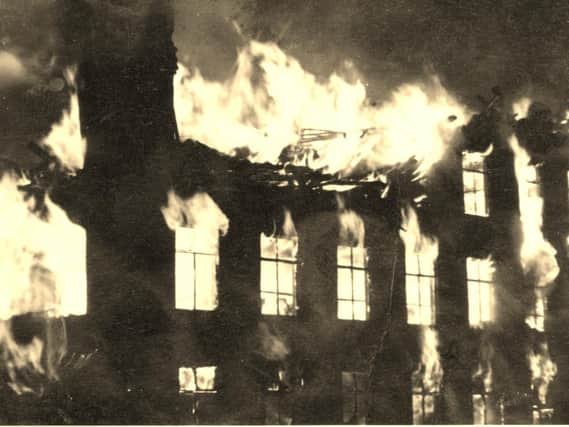Preston labourer killed after falling 60ft from a burnt-out mill


There was in the 1870s numerous mill fires in Preston and the surrounding areas.
One such blaze occurred in late January 1871 when a Thursday afternoon fire broke out in the Bloomfield Mill, off North Road, owned by Messrs Richard Threlfall & Sons, which after burning for several hours resulted in complete destruction of the premises.
Advertisement
Hide AdAdvertisement
Hide AdFlames quickly spread through the five-storey high structure despite the efforts of the mill hands and the Preston Fire Brigade who rushed from their Tithebarn Street headquarters.
The flames rose over 100 yards above the mill and the sound of windows cracked by the heat and floors collapsing showed the hopelessness of the firefighters attempts to quell the blaze as they sprayed the structure with water from the nearby mill lodge.
Fortunately, they prevented the blaze spreading to nearby weaving sheds and an early warning had ensured all the mill hands had evacuated the premises quickly. Over 500 operatives faced a bleak future and the cost of the blaze was reckoned to be over £30,000. Thankfully, the business was insured and plans were drawn up to rebuild the burnt-out mill.
Work was under way within weeks and a team of bricklayers set to the task.
Advertisement
Hide AdAdvertisement
Hide AdBy the summer great progress had been made and the builders were praised for their endeavours.
Sadly on the second Wednesday of August there was an unexpected setback when a dramatic incident unfolded.
Late that afternoon a number of brick setters and labourers were at work building up a gable end of the mill when it suddenly fell outwards with a loud crash.
The collapse being caused by the snapping of a beam which forced the wall outwards.
Advertisement
Hide AdAdvertisement
Hide AdWithout warning four of the men were hurtled downwards landing on some joists 20 feet below, but Thomas Gibbons was less fortunate and plummeted to the ground a distance of 60 feet.
Other workers rushed to clear the rubble from around their stricken colleague, but he was greatly disfigured and quite dead.
On the Thursday evening an inquest was held at the Earl Street police station before Coroner Miles Myres.
The injuries to the other workers involved were said to be relatively minor with William Cowell having a thigh crushed, William Kuen having bruises to his legs and arms and the others who fell the shorter distance relatively unscathed.
Advertisement
Hide AdAdvertisement
Hide AdWilliam Kuen, labourer, was well enough to attend the hearing and he explained how the deceased was working much higher when the collapse occurred and he had seen his lifeless body when it was recovered.
He stated that there was no warning before the fourteen inch wall fell, it having been connected to a portion of the old mill wall and built on strong foundations.
The contractor responsible for the wall was Henry Porter, and James Coward, a senior bricklayer, employed by him testified, thus - ‘I was on the next floor to the deceased and left him about five minutes before the crash and I fell two storeys.
“The wall gave way without warning, I can form no notion as to what the cause was; the timber was all good and the brickwork perfectly straight.
Advertisement
Hide AdAdvertisement
Hide Ad“Not sure how the joists were secured in the old part but they seemed sound.”
The coroner after a lengthy summing up sent the jury out and they returned from their deliberations with a verdict of ‘Accidental Death’.
The Bloomfield Mill eventually got up and running again, but by July 1873 due to a downturn in the cotton trade they were forced to suspend operations and call in their creditors.
The mill was later known as Broomfield Mill and was owned by Messrs. John Anderton, who also ran the Grimshaw Street Mill.